|
|
|
| PROJECT APOLLO - Program Introduction - Part 2 | |
|
A complex effort unequaled in space communications is being undertaken by Collins Radio Company in designing and building the Communications and Data system to be carried aboard the Apollo spacecraft. Apollo will carry three U. S. astronauts for the first U. S. voyage to the moon. Communications in terms of human language and electrical language are vital to the success of this mission throughout all phases of the flight, including prelaunch, launch, earth orbit, flight to the moon, return to earth, and recovery. This effort, while similar to the Collins role in the Mercury program, is many times more complex and advanced. It involves a research and development effort which is the largest in the company's history. |
|
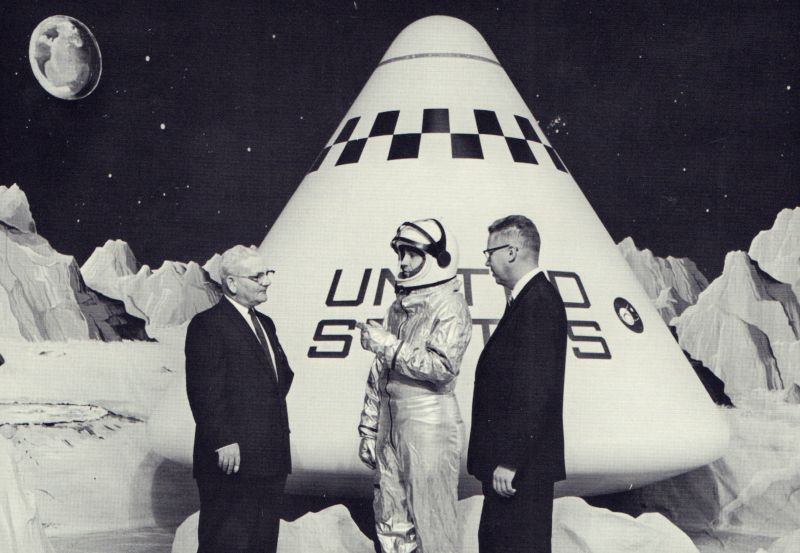 Collins Development Engineers discuss communications aspects of Apollo project. Company's full-scale spacecraft mock-up is in background. |
|
|
Under the terms of its more than $40 million contract from North American Aviation's Space and Information Systems Division, Collins plans for the Communications and Data system for Apollo include electronics equipment for the following functions: Voice Communications Intercommunications Telemetry Equipment Television In addition to the "real time" television system, a closed loop television system will be provided to permit viewing of external and remote sections of the spacecraft during the flight. Data Storage Tracking and Ranging Rescue Equipment |
|
|
Specific equipment to be supplied for the Apollo program by Collins includes the following: In order to provide the most flexible, reliable, and maintainable equipment, the entire system will be designed an "Integrated Modular Concept." This means that the various black boxes will be built according to a standard set of dimensions and that each black box will have a series of modules for the various electronic circuits. These are centralized in the spacecraft in a standard electronics installation rack and may be easily removed for repair and maintenance. All vital modules will be carried as spares aboard the spacecraft and by means of an inflight test and maintenance system, the astronaut will be able to locate trouble in the individual module and replace the defective one from the spares carried aboard. This will be a significant factor in increasing the reliability of the equipment. The use of the "Integrated Modular Concept" also permits ease of updating the system. |
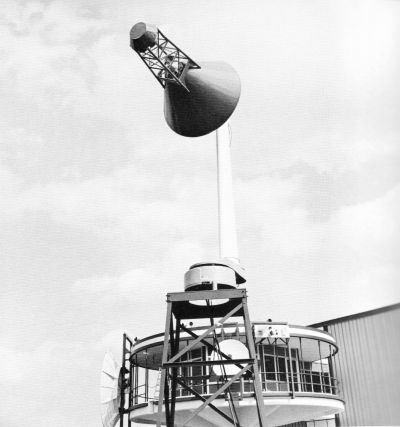 One-third scale mock-up of Apollo spacecraft is mounted on a range rotator at the Collins Antenna Division in Dallas. Complex antenna pattern measurements are made at this facility. |
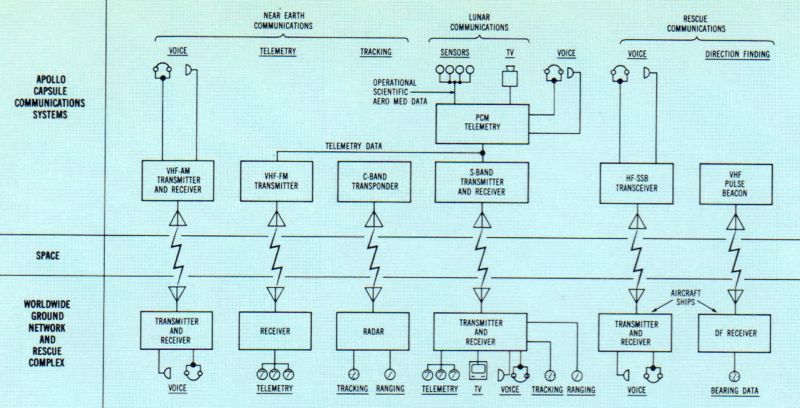 PROJECT APOLLO COMMUNICATIONS SYSTEM |
Another important factor in increasing the reliability of equipment will be in the provision for cooling. Apollo uses a unique liquid cooling system in which the individual space electronics packages (SEP) are mounted on plates which have liquid circulating in them. This is an innovation since in past installations, the cooling has been accomplished largely by cold plates. This "Integrated Modular Concept" was pioneered by Collins several years ago in its application to the CNI systems and later in the mock-ups for specific space application which pointed the way for the present Apollo concept. As in any space mission, environmental performance of the electronics equipment on board the Apollo craft will be essential toward mission success. Each flight phase of the program will have differing requirements. During the launch phase, vibration, shock, and acoustical noise will be of paramount importance. During the orbit, lunar flight, re-entry, and landing phases, temperature, pressure, and shock will be serious problems. The two most serious problems are vibration and temperature. The vibration problem will be solved by throughbolt construction which compresses all the modules in the space electronics package and holds them as a rigid structural member, prohibiting excessive build-up of vibrations. Use of foam encapsulation will also assist in solving this problem. It is anticipated that the liquid cooling approach will adequately solve the temperature problems. As in Project Mercury, reliability of the equipment is a paramount factor. |
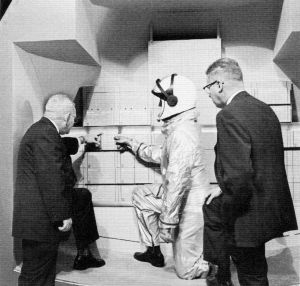 Communication equipment is in a modular or "building block" style. |
Realizing that a failure in the communications equipment would jeopardize the safety of the crew and compromise the mission performance, Collins has formed an Apollo reliability team to insure that no aspect is overlooked in this area. In addition to the equipment to be supplied for the Apollo spacecraft, Collins is responsible for development of the ground support equipment (CSE). This will include a complicated array of bench maintenance racks which will check out each part of the telecommunications system. The ground support equipment will be used during Collins' manufacturing and testing phases of the program as well as at Space & Information Systems Division of North American Aviation, Inc. and at Cape Canaveral and other field sites. The complexity of this equipment approaches the complexity of the equipment being developed for the spacecraft and is a substantial portion of the Apollo program at Collins. In addition, a systems test equipment console will check out the complete installation of communications equipment in the Apollo spacecraft at the system level. The system test equipment will be of the semi-automatic type and will provide a complete read-out of the operating parameters of the communications and data system to establish proper performance levels through-out the various phases of the Apollo program. |
|
All three of Collins' major divisions and a team of 10 to 15 subcontractors will be involved in the development of this equipment. The Apollo Project Office is located in Cedar Rapids and is headed by Dr. S. E. Watson. R. J. Pierce is the Technical Director of the program. The Collins Dallas Division will participate in antenna development and in special studies of the ground operational support system. This work is under the direction of A. J. Svien. In Newport Beach, California, the Collins Information Science Center will head a team working in the digital data aspects of the system. This work is headed by R. R. Mosier, Director of Research. Dr. Watson pointed out that this very complex space program presents a tremendous challenge in management and engineering to accomplish the job successfully. Pierce stated that the scope of the project is so complex that it involves practically every communication discipline now utilized in the art of transporting human and electrical language over radio links. He also stated that it will take a technical effort on the part of Collins and its team of subcontractors far above anything ever attempted in the field of space communications. |
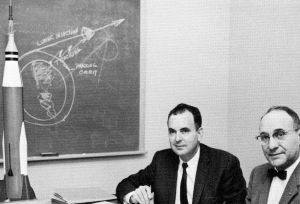 Key roles in Collins Apollo program are played by Dr. S. E. Watson,left, project director; and R. J. Pierce, technical director. |
| —Collins Signal, Issue 47, Volume 10-3, 1962 - Pages 13-15 | |